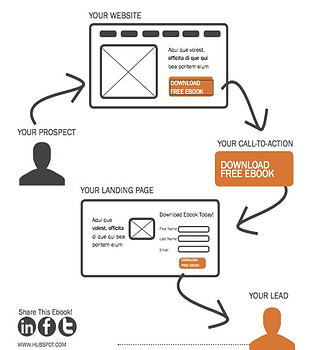 A recent study conducted by the Corporate Executive Board in partnership with Google found that the average B2B buyer completes 57% of their purchasing process before ever coming into contact with a salesperson. If you're not using inbound marketing to attract buyers to your digital content, you won't get the chance to be part of the conversation during the vendor evaluation stage of their buying process. That's why savvy technology companies are implementing inbound marketing programs. Many tech companies start an inbound marketing program only to be disappointed with their lack of results. Here are 4 common inbound marketing mistakes that prevent tech companies from achieving inbound marketing success.
A recent study conducted by the Corporate Executive Board in partnership with Google found that the average B2B buyer completes 57% of their purchasing process before ever coming into contact with a salesperson. If you're not using inbound marketing to attract buyers to your digital content, you won't get the chance to be part of the conversation during the vendor evaluation stage of their buying process. That's why savvy technology companies are implementing inbound marketing programs. Many tech companies start an inbound marketing program only to be disappointed with their lack of results. Here are 4 common inbound marketing mistakes that prevent tech companies from achieving inbound marketing success.
They Think That SEO Is Inbound Marketing
Many technology companies believe that SEO is the same thing as inbound marketing. They work with SEO specialists to optimize their websites for targeted keywords and work at building links to their websites. They fail to attract qualified buyers to their website and conclude that inbound marketing doesn't work.
What they fail to realize is that SEO is not inbound marketing. In many respects, SEO isn't even SEO anymore. Google's Panda and Penguin algorithm updates of the past two years have changed the rules of the game. While technical SEO is still important, the new SEO rules favor websites that frequently produce good content relevant to their targeted keywords. Social media love in the form of shares, likes and favorites is a further signal to Google that the site is relevant to the targeted search terms. While technical SEO is still important, it's only table stakes. Technology companies need to produce content that educates the buyer during the research phase in order to be part of the vendor evaluation process.
So what does this mean to technology companies? It means that you need to produce eBooks, videos and webinars to educate potential buyers when they're researching solutions. It means that you need to blog about topics that interest potential buyers. It means that you need to share your content on social media networks so that it will be shared, liked and favorited. In short, content creation trumps technical SEO.
They Don't Capture Leads
Many tech companies understand the need for content creation and begin producing eBooks, webinars, videos and blog articles. Again, they're disappointed when they fail to generate more leads and customers. The reason that they fail to move the needle on the metrics that matter is that they don't have mechanisms in place to capture leads. Here is a graphic depiction of the lead generation process (image courtesy of HubSpot.)

Every blog article you write should be optimized for lead generation. Why is this important? Depending on the source, it's estimated that 75% to 90% of buyers aren't ready to buy when they first come to your website. By offering premium content like an eBook or a video in exchange for contact information (e.g. - an email address), you earn the opportunity to nurture the lead as they progress through their buying process. Remember, the average B2B buyers completes 57% of their purchase process before they ever talk to you. Earn the opportunity to talk to them by giving them appropriate information as they research solutions to their problems.
They Don't Use Marketing Automation Software
Inbound marketing is a coordinated series of processes including SEO, content marketing, social media, inbound lead generation, lead nurturing and marketing analytics. Your success generating leads and new customers is determined by how well you align with your customer's buying process using these tactics. Many technology companies try to run their inbound marketing process by patching together blogging platforms, Google analytics, social media networks and non-automated email campaigns. Again, they find that they don't produce the results they expected.
There are many affordable, cloud-based marketing automation software platforms available that automate most, if not all, of the inbound marketing process. We use HubSpot because it provides an all-in-one internet marketing software platform that lets us execute all of the tactics mentioned in this article. Optify and InfusionSoft are two other affordable marketing automation software platforms.
Inbound marketing is different than traditional marketing in that every element of every campaign can be measured and optimized. Marketing automation software lets you determine which of your efforts are working and which aren't. Using this data, you can do more of what's working and either jettison or improve tactics that aren't producing desired results.
They Don't Align Their Sales Process With Inbound Marketing
Perhaps the most important element of inbound marketing is how well you're able to transition leads from digital relationships to personal ones. After all, unless you're an e-commerce company, your sales team will need to close the deal. In the context of the CEB/Google research, how well do you transition the relationship to your sales team after the buyer completes the first 57% of their buying process?
Technology companies that use inbound marketing successfully involve their sales team in the process from the very beginning. Sales helps define ideal customer profiles, shares commonly heard questions that can be answered in content produced and provides feedback on the quality of leads. Marketing automation software let's salespeople see which content offers their prospects are accessing and alerts them when their prospects come to your website. A well-crafted inbound marketing program involves sales in the planning stages and provides them with lead intelligence that helps them improve closing ratios.
Summary
If you've implemented an inbound marketing program and you're not getting the results you hoped for, look to see if you're making one of these 4 mistakes. Quite often, one or more of these mistakes is the difference between failure and success. While brand awareness and social engagement are nice, most technology companies start inbound marketing to generate more qualified leads and customers. If you use a coordinated, optimized process, you will be successful.









